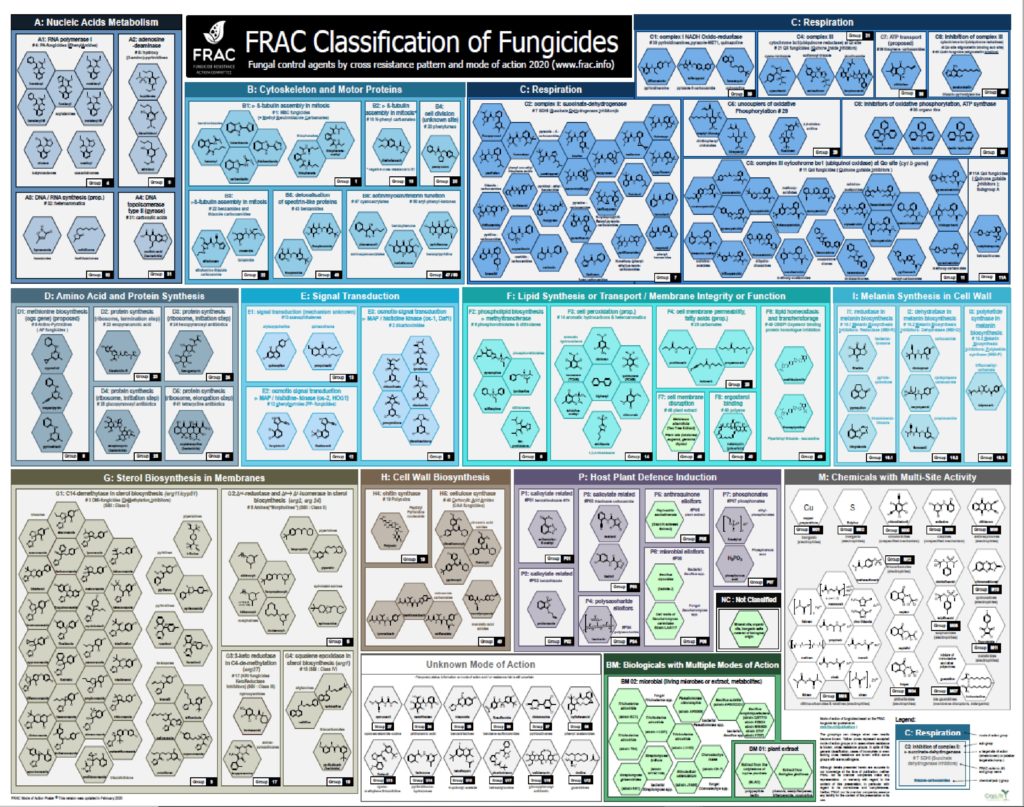A frequently asked question is “What is a FRAC group?” FRAC is short for “Fungicide Resistance Action Committee”. Simply put, it is a grouping of fungicides based on the mode of action. This numbering system helps users easily identify which type of fungicide chemistry they are using without having to worry about various trade names. It is an excellent tool to help with fungicide rotations to manage and prevent resistance.

Fungicide resistance is a numbers game. Fungal pathogens have broad genetic diversity. This means that there is a chance that populations within the same pathogen species may be resistant to the applied fungicide. If this fungicide is applied in successive treatments, this population will continue to infect and spread amongst the host plant. Rotating to different chemistries reduces the risk of these “escapees.” It is important to note that resistance is not due to repeated applications of the same fungicide to the fungal pathogen, but rather that there already exists a resistant population of the pathogen. This resistant population is unaffected by the fungicide because of differences in its genetic code, and will continue to grow unless an alternate fungicide is used. More information on fungicide resistance, which includes some illustrated examples, can be found in this previous article on the Almond Doctor.
FRAC groups were established in the early 1980’s. Each fungicide mode of action has a unique code. These codes are updated regularly to consider the changing availability of fungicide chemistries. They include both synthetic, microbial derived, and plant-based fungicides. FRAC numbers are easy to use and the rules are simple. If wanting to reduce fungicide resistance, do not apply the same FRAC group in successive fungicide sprays. By developing fungicide rotation programs, the odds of resistance formation are significantly reduced. This helps keep the fungicide chemistry effective longer, leading to eventual price reductions to the grower as generics are released. More information on the FRAC organization and fungicide grouping can be found here.
Some believe that the risk of fungicide resistance is too small to be concerned with fungicide rotation. This isn’t true. Within California, there are several cases of fungicide resistance in different pathogens. These include:
- Brown rot: strains within California have been found to be resistant to thiophanate-methyl (FRAC 1);
- Alternaria: Populations within the southern San Joaquin valley have developed resistance to strobilurins (FRAC 11) and SDHI (FRAC 7) chemistries;
- Scab: There have been multiple reports of resistance to strobilurins (FRAC 11);
- Walnut blight: This bacterial pathogen has developed resistance to copper (FRAC M1).
As farmers, it is our job to protect our tools for future use. To increase the life of fungicides, we need to plan our fungicide program, spray only when conditions are conducive for disease, and avoid spraying when pathogen populations are too high. Remember, it takes years, if not decades, for new chemistries to be developed. As such, these novel chemistries will be more expensive. Only by preserving what we have will we retain cost effective tools for disease management.


Preventing spring diseases in almond - The Almond Doctor
March 23, 2023[…] brand names may use the same fungicide chemistry. This process has been streamlined through the use of a FRAC number. This number indicates the mode of action of the fungicide, and use of the same number in […]